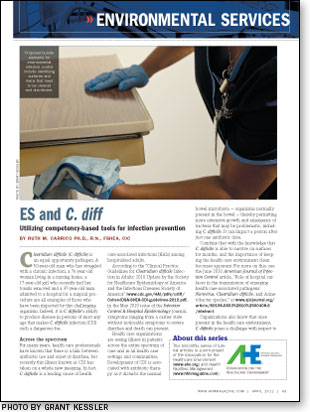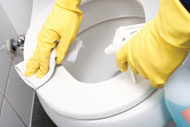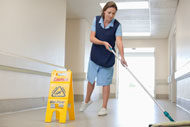 Clostridium difficile (C. difficile) is an equal opportunity pathogen. A 50-year-old man who has struggled with a chronic infection, a 76-year-old woman living in a nursing home, a 17-year-old girl who recently had her tonsils removed and a 37-year-old man admitted to a hospital for a surgical procedure are all examples of those who have been impacted by this challenging organism. Indeed, it is C. difficile's ability to produce disease in persons of most any age that makes C. difficile infection (CDI) such a dangerous foe.
Clostridium difficile (C. difficile) is an equal opportunity pathogen. A 50-year-old man who has struggled with a chronic infection, a 76-year-old woman living in a nursing home, a 17-year-old girl who recently had her tonsils removed and a 37-year-old man admitted to a hospital for a surgical procedure are all examples of those who have been impacted by this challenging organism. Indeed, it is C. difficile's ability to produce disease in persons of most any age that makes C. difficile infection (CDI) such a dangerous foe.
Across the spectrum
For many years, health care professionals have known that there is a link between antibiotic use and onset of diarrhea, but recently this illness known as CDI has taken on a whole new meaning. In fact, C. difficile is a leading cause of health care-associated infections (HAIs) among hospitalized adults.
According to the "Clinical Practice Guidelines for Clostridium difficile Infection in Adults: 2010 Update by the Society for Healthcare Epidemiology of America and the Infectious Diseases Society of America" (www.cdc.gov/HAI/pdfs/cdiff/Cohen-IDSA-SHEA-CDI-guidelines-2010.pdf), in the May 2010 issue of the Infection Control & Hospital Epidemiology journal, symptoms ranging from a carrier state without noticeable symptoms to severe diarrhea and death can present.
Health care organizations are seeing illness in patients across the entire spectrum of care and in all health care settings and communities. Development of CDI is associated with antibiotic therapy as it disturbs the normal bowel microbiota — organisms normally present in the bowel — thereby permitting more extensive growth and emergence of bacteria that may be problematic, including C. difficile. It can impact a person after just one antibiotic dose.
Combine that with the knowledge that C. difficile is able to survive on surfaces for months, and the importance of keeping the health care environment clean becomes apparent. For more on this, see the June 2010 American Journal of Infection Control article, "Role of hospital surfaces in the transmission of emerging health care-associated pathogens: Norovirus, Clostridium difficile, and Acinetobacter species."
Organizations also know that once present in the health care environment, C. difficile poses a challenge with respect to physical removal of the organism followed by disinfection of surfaces. According to an article in the June 2010 issue of Infection Control & Hospital Epidemiology titled "Effectiveness of alcohol-based hand rubs for removal of Clostridium difficile spores from hands" (www.ncbi.nlm.nih.gov/pubmed/20429659), the organism is also particularly adherent to the hands of health care personnel (and probably the hands of the patients themselves as well as their visitors) and environmental surfaces.
Because the organism is capable of adapting to harsh environmental conditions, typical germicides are not universally effective. In fact, recommendations include the use of sporicidal agents, such as sodium hypochlorite (bleach) solutions, when performing environmental cleaning and disinfection when an outbreak is known or suspected or when there is evidence of ongoing disease transmission, states the October 2008 Infection Control & Hospital Epidemiology journal article, "Strategies to prevent Clostridium difficile infections in acute care hospitals" (www.ncbi.nlm.nih.gov/pubmed/18840091).
The need to rapidly implement a change in cleaning and disinfection practices (for example, during an outbreak situation or when ongoing transmission is present) adds another level of complexity to the task of health care environmental cleaning and disinfection. Not only do organizations need to consider adding to their existing products, but they also need to have a mechanism that allows them to change products at any time and provide real-time staff training to address patient safety needs.
Some health care facilities even have made sporicidal agents their disinfectant of first choice to prevent confusion, promote health care staff training and maintain a consistent approach to environmental disinfection.
Addressing CDI
Dealing with the burgeoning number of CDI cases has brought to light the critical importance of teamwork in responding to and preventing illness and infection transmission. Environmental services departments are key to a successful team response, but the issue is not theirs alone.
Some important considerations include how to get started, what resources are necessary, whom to include on the team and how to know if and when the cleaning activities have been successful.
First, health facility professionals need to "plan the plan." That means they should gather their teams together based upon an assessment of all the disciplines that have a role in addressing CDI and preventing its transmission. Most often, this will at least include infection prevention, environmental services, materials management, nursing, education and ancillary services. It is also important for the team to consider adding a member of the administration as resources may need to be allocated and the team will want to make sure their activities align with the goals of the organization.
Next, health facility professionals need to identify where and when to meet and assign specific responsibilities. Ensuring accountability in the process is critical. Each participant is responsible for being fully engaged. To accomplish that, it is important that the goals are outlined at the beginning of the process along with a determination of the desired outcomes: What does the team hope to accomplish? What will the team be doing to get there? How will the team know when it has completed the task?
Obviously, this makes a complex and difficult process look very easy. Most assuredly, it will not be easy, so health facility professionals should be prepared to take it one step at a time and use some performance improvement tools to make it happen. One of these important tools involves the use of a training and education process based on the ability to apply knowledge in the workplace. Competency-based training, or the ability to move practice knowledge into action, is a foundation to a sustainable and reliable process. For example, a study in the December 2008 issue of the American Journal of Infection Control, "Infection prevention and control competencies for hospital-based healthcare personnel" (www.ncbi.nlm.nih.gov/pubmed/19084164), described developing a list of competencies and measurable activities for hospital-based health care personnel to use during routine patient care activities as well as during natural and man-made disasters.
The Association for the Healthcare Environment (AHE) provides training materials that are rooted in this system and enable a methodical approach that includes an evaluative component. Those materials incorporate a basic framework for competency-based training built upon measurable and actionable outcomes that the trained worker is expected to demonstrate. The competencies then can be applied into a bundle of activities that can be a basis for focusing environmental cleaning and disinfection efforts and enabling active participation by personnel across the health care spectrum.
Use of a bundle approach in improving performance is probably well-known to most health care personnel. Central line bundles, ventilator bundles and urinary catheter bundles have been used to target specific interventions associated with improved outcomes.
Proposed bundle elements for environmental infection control include selecting, mixing and using the correct germicide according to facility policy; identifying surfaces and items that need cleaning and disinfection and the frequency of those activities; selecting and using personal protective equipment to ensure the safety of the worker during use of chemical disinfectants and when in environments posing a risk of microorganism transmission; using correct techniques when cleaning and disinfecting surfaces; identifying and reporting breaches in infection prevention practice by any health care personnel; and using activities that prevent infection, including safe work practices and immunization.
To learn more about these bundle elements, readers are encouraged to check out Clean Spaces Healthy Patients, a collaborative project between AHE and the Association for Professionals in Infection Control and Epidemiology at http://cleanspaces.site.apic.org. This website provides free online tools and resources aimed toward environmental services and infection prevention professionals.
A faster pace
As infection issues continue to become more complicated, health care professionals must work together at a faster pace and with even greater resolve to keep ahead. Together, they will be able to achieve amazing success.
— Ruth M. Carrico Ph.D., R.N., FSHEA, CIC, is associate professor at the University of Louisville School of Public Health and Information Sciences. She can be contacted through email at ruth.carrico@louisville.edu.
| Sidebar - Demonstrating competency |
| Competency-based training for health care staff to promote infection prevention is relevant for all patients. Consider the 50-year-old male who struggles with a chronic bone infection. He has been on antibiotics numerous times and now has a Clostridium difficile (C. difficile) infection. Staff must be able to demonstrate knowledge of the following through their practice:
More information can be found at http://cleanspaces.site.apic.org/ and by reviewing the original published work. |




